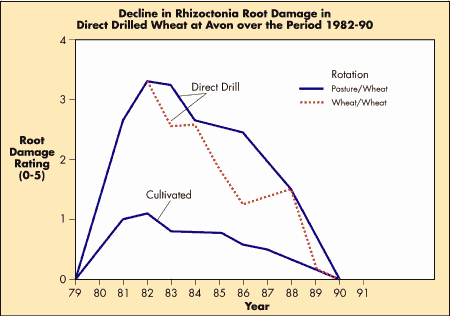
4.7 Soil Disease and Suppressive Soils
Root disease can be a major restriction to plant
production in all sectors. When root disease is observed in crops, we are
actually seeing an imbalance in the soil biota food web, coinciding with
appropriate environmental conditions. These changes have permitted a
pathogenic organism to become dominant.
Throughout the world examples have been found of soils
that are able to suppress disease. One of the most familiar examples is
'take-all decline' following 4-6 consecutive wheat or barley crops.
Disease levels increase initially and yield declines in the first 3-4
years, but after this the level of disease falls and yield increases. This
particular decline phenomenon is only seen in higher rainfall areas,
especially in Europe and North America.
The following information is based on research relating to
cereal root disease. However, the principles relating to increasing the
suppressive characteristics of a soil are the same across all production
sectors.
Factors Contributing to Suppressive Soils
An important point to consider is that all soils have a
natural level of disease suppressive activities. In most soils long term
management can either reduce or increase this level of suppression.
A number of management factors have been associated with
increases in the level of soil suppression to cereal root disease. These
include intensification in cropping, moderate to high levels of nutrients,
management of weeds, pests and other diseases, stubble retention and
limited grazing.
All these factors have a common end result - an increased
return of residues to the soil, providing a large food supply to fuel
microbial activity.
Crops infected with root disease will return less stubble
and, consequently, organic matter to the soil, than a healthy crop. Less
stubble means less food and lower microbial activity.
In broadacre cropping, rotations have been an important
part of the root disease control strategy and, hence, a major influence on
yields. In the long term trials at Avon, South Australia, it was found
that the influence of rotation on the control of root fungal disease was
greatly reduced once the level of soil suppression had increased. This is
clearly illustrated in Figure 1.
In these experiments prior to 1989, wheat following a
range of different crops showed considerable yield variability. For
example, in 1979 a wheat following peas produced 3t/ha compared to wheat
following wheat at 1.75t/ha, a difference of 1.25t/ha, due to high level
of take-all root disease in the wheat following wheat. In 1994, the
difference in yield was reduced to 0.6t/ha. Over the life of the trial a
very similar result was observed for the direct drilled and conventional
cultivation treatments.
Rotations that include a break crop such as grain legume
or canola greatly reduce root disease in cereals because these crops do
not host the cereal root disease fungi. Canola has a second beneficial
effect, the release of chemicals into the soil which kill root disease
causing fungi and other soil organisms. This process is known as 'biofumigation'.
Rotations will continue to play an important role in root
disease control, but an increase in the level of root disease suppressive
activity in the soil will allow far greater flexibility in the choice of
rotations.
Results from the long term trials in South Australia
indicate that increased root disease does occur when conservation farming
is first introduced, but this can be significantly reduced over time
without the re-introduction of burning and tillage.
The adoption of conservation farming practices results in
the formation of a whole new soil environment and, consequently, the
balance in the food web is adjusted. Different elements of the
conservation farming system impact on the soil biota in different ways.
Soil organisms are concentrated into the top 10cm of soil.
The use of minimum tillage reduces soil mixing, maintaining biota
concentrations near the surface rather than diluting them through a
greater depth. For some Australian soils, the greater the number of
tillage passes, the greater the risk of soil erosion. Erosion results in
the removal of topsoil, the home of the soil biota.
When soil is lost from a paddock it will take soil
organisms along with it.
Stubble retention has a significant effect on the level of
organic material (carbon) returned to the soil. Plant residues are a vital
energy source for many soil biota and readily available carbon energy
sources will result in rapid multiplication of the soil population.
Stubble retention can also reduce moisture evaporation that may be
beneficial to some organisms. Conversely, stubble burning not only allows
greater moisture loss, but also physically heats the soil surface layer.
This will be detrimental to some organisms.
Figure 1:
Decline in root damage by Rhizoctonia under different rotations
and cultivation methods.


4.7 Soil Disease and Suppressive Soils
[ Back ]
|
